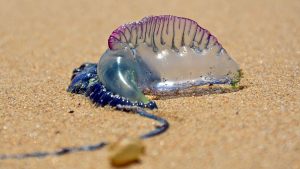The Stingray Shuffle and Other “Life” on the Beach
You already know the “Baby Shark” song and dance but do you know the “Stingray Shuffle”? It’s definitely one you and your family should add to your dance list before heading to the beach. Actually, there are several things beach goers should know to have the safest possible family beach vacation. Below are some quick tips to help you safely enjoy the beach.
- “The Stingray Shuffle” – Stingrays like to bury themselves in the sand in shallow coastal waters. When walking in shallow waters shift (shuffle) your feet back and forth to scare off any hiding rays.
- Jellyfish – Although some jellyfish are harmless, others can be deadly. Best advice is to assume all are dangerous because they can continue to sting even if they are dead! If you are stung (and you are SURE it was from a jellyfish) get out of the water, rinse the area with SEA WATER, NOT FRESH WATER, and try to remove any tentacles. Remove them with an object OTHER THAN YOUR HAND so you don’t get stung again. Some stings will need further emergency medical treatment so watch closely!
- Portuguese Man of War – These guys are almost always bad news! Many times they are blue in color and their stings can cause welts accompanied by swelling and moderate to severe pain. These local symptoms last for two to three days. Avoidance and wetsuits or even hooded vests for divers are key. If stung, do NOT rub the area. Remove any tentacles with tweezers or gloves, flush the area with SEAWATER, apply heat and watch in case further emergency medical treatment is required.
- Rip Currents – These are powerful channels of water near the shoreline that flow away from the land. They can be fast, strong and difficult to spot. In the United States, they are responsible for up to 80% of all lifeguard rescues/year and 100 drowning deaths/year. They are commonly but incorrectly, referred to as “riptides” or “undertow”, which have everything to do with the tide and waves and nothing to do with currents. To prevent being caught in a rip current, don’t swim alone and don’t swim in remote areas or near piers and jetties. If you get caught in a rip current, don’t panic. Try to swim PARALLEL to the shore. If you get too tired to swim, float or tread water. For more information or rip current safety…
Of course this list is not all inclusive. Don’t forget about sunburn, dehydration, routine injuries, swim safety, polluted water, and even falling coconuts! The list can go one, but you are probably half way to the beach…




